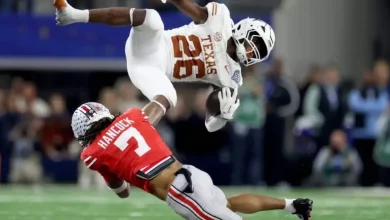Texas and Georgia’s college football programs have such high valuations that, if sold, they would be worth amounts comparable to NFL franchises, highlighting their immense financial worth and market value.

In the landscape of American sports, college football stands as a cultural and financial powerhouse. Among its most prominent programs, the University of Texas and the University of Georgia have emerged as exemplars of immense valuation, so much so that if their athletic programs were to be sold on the open market, they would command prices comparable to some of the most valuable NFL franchises. This phenomenon underscores not only the financial heft of these programs but also their deep-rooted cultural significance, widespread fan engagement, and strategic business models. This comprehensive analysis explores how Texas and Georgia’s college football programs have reached such extraordinary valuation levels, examines the factors that drive their worth, and considers the broader implications for college athletics, sports business, and American sports culture.
The Rise of College Football Valuations: Context and Significance
Historically, college football has been seen as a regional passion, a source of school pride, and a feeder for professional leagues. However, in recent decades, its economic impact has skyrocketed, transforming college programs into multi-billion-dollar enterprises. The valuation of a college football program encompasses numerous factors: revenue streams, brand strength, media rights, facilities, alumni engagement, and market demographics.
Texas and Georgia exemplify this trend, with their programs reaching valuation estimates that rival NFL teams. These valuations are driven by a combination of factors, including their national popularity, historical success, media rights deals, and the size and loyalty of their fan bases.
Quantifying the Valuations: How Much Are Texas and Georgia Worth?
According to various industry analyses, including Forbes and sports finance experts, the University of Texas’s football program is valued at approximately $1.2 billion to $1.5 billion, making it one of the most valuable college sports programs. Similarly, the University of Georgia’s football program is estimated to be worth around $1 billion.
To put these numbers into perspective, many NFL franchises are valued in the range of $3 billion to over $6 billion. For instance, the Dallas Cowboys, the most valuable NFL team, are worth over $8 billion. While Texas and Georgia’s programs do not reach the valuations of the league’s top franchises, their figures are nonetheless staggering for college athletics and demonstrate how integral college football has become to the financial fabric of sports.
Factors Contributing to High Valuations
1. Massive Fan Bases and Alumni Engagement
The size and loyalty of a program’s fan base are foundational to its valuation. Texas, with its massive alumni network and nationwide following, commands a high level of support and merchandise sales. The Longhorns’ brand is synonymous with college football culture, and their games are broadcast nationally, drawing millions of viewers.
Georgia, similarly, boasts a passionate, deeply rooted fan base that extends beyond the state, thanks to its successful football history and the appeal of the Southeastern Conference (SEC). The Bulldogs’ sustained success has built a strong brand that translates into lucrative media deals and merchandise sales.
2. Successful Athletic Performance and Winning Tradition
Success on the field directly correlates with increased revenue and valuation. Programs with recent national championships, consistent winning records, and high-profile players attract more viewers, sponsorships, and lucrative media rights. Texas, with its storied history and recent resurgence, remains a perennial powerhouse. Georgia’s back-to-back national championships in 2021 and 2022 further solidify its stature.
3. Media Rights and Broadcasting Deals
One of the most significant contributors to valuation is the revenue from media rights. College football’s television contracts, especially within conferences like the SEC, generate billions of dollars annually. The SEC’s media rights deal, for example, is worth over $300 million annually, with a significant portion attributable to Georgia’s games.
Texas’s move to the SEC in 2024 is expected to boost its media revenue further, given the conference’s lucrative media rights packages. The ability to broadcast games across multiple platforms, including cable, streaming, and international markets, enhances the financial value of these programs.
4. Stadiums and Facilities
State-of-the-art stadiums and training facilities contribute significantly to program valuation. Texas’s Darrell K Royal–Texas Memorial Stadium, with a capacity of over 100,000, is among the largest in college football. Georgia’s Sanford Stadium is similarly iconic and modern. These facilities not only generate revenue through ticket sales but also serve as marketing assets that attract recruits and sponsors.
5. Commercial Sponsorships and Licensing
Partnerships with major brands, including apparel companies, beverage sponsors, and local businesses, boost revenue streams. Georgia and Texas have lucrative sponsorship deals that contribute to their overall valuation.
6. Licensing and Merchandising
Merchandise sales—jerseys, hats, memorabilia—are substantial for these programs. The iconic logos and team colors of Texas and Georgia are recognized worldwide, and licensing agreements generate significant income.
7. Recruitment and Future Potential
The ability to attract top-tier recruits enhances program valuation. Both schools consistently land highly-rated recruits, ensuring continued on-field success, which sustains and elevates their financial worth.
Broader Implications of High Program Valuations
1. Financial Powerhouses in College Sports
The enormous valuations place programs like Texas and Georgia as financial giants within college sports, comparable to professional franchises. This has implications for how athletic departments allocate resources, negotiate media rights, and attract sponsorships.
2. Impact on Conference Realignment and College Football Ecosystem
High valuations influence conference dynamics. Schools with valuable programs become central to media rights negotiations and conference expansion strategies. Texas’s move to the SEC exemplifies this trend, aiming to capitalize on its market power.
3. Commercialization and the Future of College Athletics
The financial magnitude of these programs raises questions about the commercialization of college sports, athlete compensation, and the future landscape. The NCAA’s traditional amateurism model faces ongoing scrutiny as programs generate billions.
4. Relevance to Other Sports and Markets
The valuation trends of college football programs reflect a broader sports business phenomenon: the monetization of local and national sports brands. These programs serve as case studies for sports marketers, investors, and media companies.
Challenges and Criticisms
Despite their impressive valuations, these programs face challenges:
Academic and Ethical Concerns: The commercialization of college sports can sometimes overshadow educational missions and raise ethical questions about athlete treatment.
Revenue Disparities: While Texas and Georgia are highly valued, many programs struggle financially, leading to disparities and competitive imbalances.
Sustainability: Maintaining high valuations requires continual success and innovation, which can be threatened by coaching changes, NCAA regulations, or external economic factors.
The New Era of College Football Powerhouses
The high valuations of Texas and Georgia’s college football programs exemplify the extraordinary growth and commercialization of college sports. If these programs were to be sold, their worth would rival NFL franchises, underscoring their economic and cultural significance. This shift reflects changing dynamics in sports business, media rights, fan engagement, and institutional strategy. As college football continues to evolve, these programs embody the convergence of tradition, entertainment, and commerce—setting the stage for a future where college sports are not only a source of school pride but also formidable financial entities on par with professional leagues.









